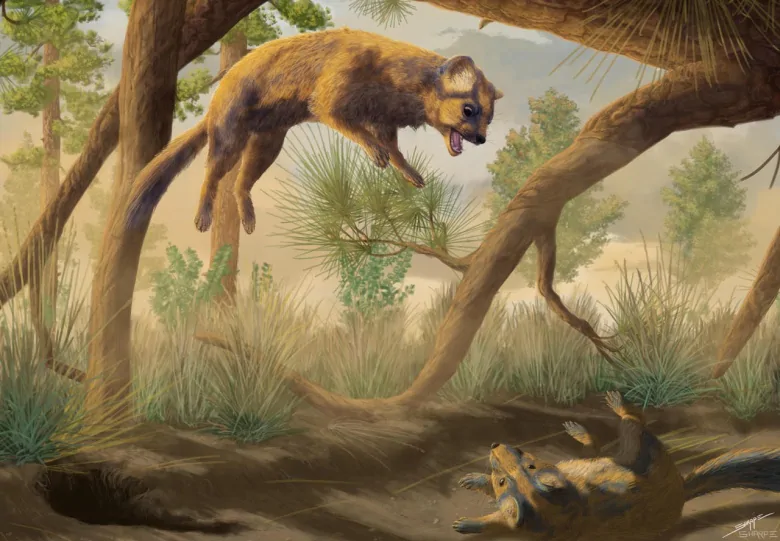Fossil identified as 'great-grandfather' of wolverines

A tiny skull once thought to belong to an ancient miniature cat is actually the earliest relative of wolverines, minks, otters and weasels ever found in North America, researchers say.
Corumictis wolsani, would have been tiny enough to sit in your hand, but trying to pick it up would probably not have been a good idea.
“It has these incredibly sharp teeth, sharper than some weasels today,” said Ryan Paterson, who led the research while doing his master’s degree at Carleton University. “It was probably a ferocious little thing, despite being the size of the tiniest weasel on the planet.”
The animal’s beautifully preserved fossil skull was unearthed from the John Day Fossil Beds in Oregon about 15 years ago by Gregory Retallack, a professor at the University of Oregon who studies ancient plants and soils.
It was identified as an ancient feline and put on display at the local museum. There, it caught the eye of Joshua Samuels, who was the museum curator and the chief paelontologist of the John Day Fossil Beds National Monument from 2010 to 2016.
At the time, Paterson was looking for the missing link between seals, sea lions and their land-dwelling ancestors as part of his master’s degree at Carleton and the Canadian Museum of Nature.
Samuels, now a geosciences professor at East Tennessee State University, got in touch, saying he thought the skull might be what Paterson was looking for.
After visiting the museum and having a look, “I thought so too,” Paterson recalled in a recent interview.

He borrowed the skull, which was just four centimetres long, and brought it back to Canada.
But once he started taking measurements, they weren’t quite right for a seal.
So the researchers CT scanned it, finding some unusual features in its inner ear and the shape of its brain that helped identify it.
“That was when we finally realized it was the earliest ancestor of weasels that was in North America,” Paterson recalled.
‘Eo-wolverine’
That led one of his colleagues to nickname it “eo-wolverine” (“eo” means “early” or “primeval” in Latin) — after the “one creature related to weasels that has kind of captured the public imagination.”
While the researchers described Corumictis as the “great-grandfather” of wolverines and Paterson says he still thinks of it as “eo-wolverine,” he and his colleagues thought naming it after wolverines specifically would be confusing. After all, it’s just as related to other weasels, such as minks and ferrets.
Instead, the new species was named after the region it was found (Corumictus means “northwest”) and a Polish researcher, Mieczysław Wolsan, who described many weasel-like fossils in Europe.
Corumictis lived between 28.8 and 25.9 million years ago during the Oligocene, a time when camels, three-toed horses and rhinos roamed North America.
That makes it at least a million years older than any other weasel found in North America before and just a couple of million years younger than the oldest weasel found in Europe, the researchers report.
At that time, the area that is now modern-day Oregon was getting cooler and drier, and forests were thinning out into more open grasslands. Burrowing rodents similar to ground squirrels and groundhogs were starting to appear. That’s the kind of prey modern weasels generally prey on.
“We thought there might be a connection between other things popping up that live in these open habitats and our own critter, Corumictus, coming on the scene,” Paterson said.
While modern weasels have long skinny bodies that allow them to squeeze and slither into rodents’ narrow burrows, the researchers have only Corumictis‘s skull and teeth and none of its body. So while they know it was tiny, they don’t yet know if it was long and skinny.
“It could be bulkier, like a wolverine,” Paterson said.
The researchers published their findings in the journal Zoological Journal of the Linnean Society
The research was funded by the Natural Sciences and Engineering Research Council of Canada.





